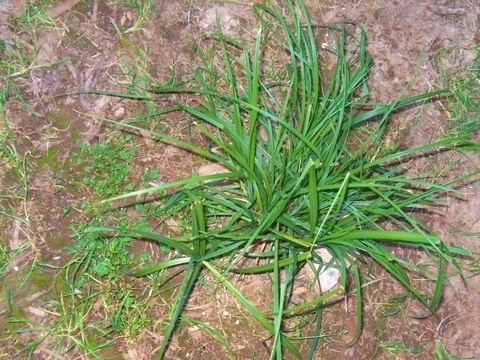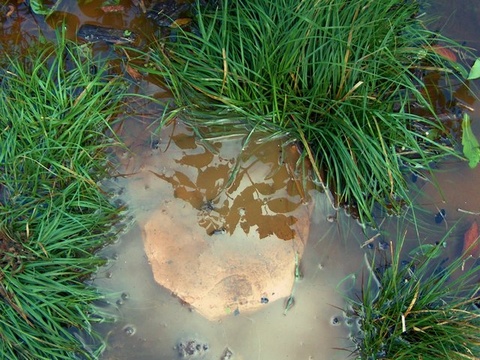Sedges are perennial grasslike plants in the sedge family. Many of them are native to the Yuba-Sutter area. In general, sedge species tend to prefer more water than grass species and to be more evergreen than grass species. Most sedges are either usually or always found in wetlands.
Flatsedges (in the genus Cyperus) tend to be weedy, spreading out of control; for example, yellow nutsedge is a native flatsedge that is a particularly common pest in gardens. Sedges in the genus Carex are easier to control and are often considered desirable garden plants; some of the smaller ones, such as clustered field sedge, are sometimes even planted as lawns. This page describes only the native sedges in the genus Carex.
Valley Sedge
 Valley sedge (Carex barbarae) in a garden in Marysville. Photo by queerbychoice. Valley sedge (also called Santa Barbara sedge) is a three-foot-tall by three-foot-wide, evergreen sedge that is native to Sutter County and typically grows at elevations below 3,000 feet. It is most often found on seasonally wet slopes in central oak woodland, valley grassland, or riparian forest. It usually grows in wetlands. It prefers moist areas, spreads aggressively, and tolerates sun or shade.
Valley sedge (Carex barbarae) in a garden in Marysville. Photo by queerbychoice. Valley sedge (also called Santa Barbara sedge) is a three-foot-tall by three-foot-wide, evergreen sedge that is native to Sutter County and typically grows at elevations below 3,000 feet. It is most often found on seasonally wet slopes in central oak woodland, valley grassland, or riparian forest. It usually grows in wetlands. It prefers moist areas, spreads aggressively, and tolerates sun or shade.
You can read more about it at the Theodore Payne Wiki. You can see pictures of it at CalPhotos, Flickr, and Picasa. You can find out where to buy it at the California Native Plant Link Exchange.
Clustered Field Sedge
 Clustered field sedge (Carex praegracilis) surrounds a submerged stepping-stone in a seasonally flooded garden in Marysville. Clustered field sedge grows very well in heavy clay soils that tend to be very dry in the summer but very wet in the winter. Photo by queerbychoice. Clustered field sedge is a one- to two-foot-tall, evergreen sedge that is native to Yuba and Sutter Counties and typically grows at elevations below 9,000 feet. It is found in valley grassland, yellow pine forest, or riparian forest. It usually grows in wetlands. It prefers regular water and tolerates sun or shade.
Clustered field sedge (Carex praegracilis) surrounds a submerged stepping-stone in a seasonally flooded garden in Marysville. Clustered field sedge grows very well in heavy clay soils that tend to be very dry in the summer but very wet in the winter. Photo by queerbychoice. Clustered field sedge is a one- to two-foot-tall, evergreen sedge that is native to Yuba and Sutter Counties and typically grows at elevations below 9,000 feet. It is found in valley grassland, yellow pine forest, or riparian forest. It usually grows in wetlands. It prefers regular water and tolerates sun or shade.
You can read more about it at the Theodore Payne Wiki, the Las Pilitas Nursery website, and USDA Conservation Plant Characteristics. You can see pictures of it at CalPhotos, Flickr, and Picasa. You can find out where to buy it at the California Native Plant Link Exchange.
Torrent Sedge
Torrent sedge (also called naked sedge) is a two-foot-tall by two-foot-wide, evergreen sedge that is native to Yuba County and typically grows at elevations between 200 and 5,000 feet. It is most often found below the high-water mark on rocky or sandy streambanks in central oak woodland, yellow pine forest, or riparian forest. It usually grows in wetlands. It prefers shade but tolerates partial sun with plenty of water.
You can read more about it at the Theodore Payne Wiki. You can see pictures of it at CalPhotos, Flickr, and Picasa. You can find out where to buy it at the California Native Plant Link Exchange.
Widefruit Sedge
Widefruit sedge (also called narrowleaf sedge) is native to Yuba County and typically grows at elevations between 2,000 and 7,500 feet. It is most often found in meadows in central oak woodland, yellow pine forest, or riparian forest. It usually grows in wetlands.
You can see pictures of it at CalPhotos, Flickr, and Picasa. You can find out where to buy it at the California Native Plant Link Exchange.
Slender Sedge
Slender sedge is native to Yuba County and typically grows at elevations between 100 and 2,000 feet. It is most often found on slopes in central oak woodland. It prefers regular water and tolerates sun or shade.
You can see pictures of it at CalPhotos, Flickr, and Picasa. You can find out where to buy it at the California Native Plant Link Exchange.
Manystem Sedge
Manystem sedge (also called forest sedge) is native to Yuba County and typically grows at elevations between 500 and 7,300 feet. It is most often found on slopes in yellow pine forest. It prefers shady areas with regular water and good drainage.
You can see pictures of it at CalPhotos, Flickr, and Picasa. You can find out where to buy it at the California Native Plant Link Exchange.
Manystem Sedge
Fragilesheath sedge is a two- to three-foot-tall by two- to three-foot-wide, drought-deciduous sedge that is native to Yuba County and typically grows at elevations between 2,500 and 11,000 feet. It is most often found in moist meadows in yellow pine forest.
You can read more about it at the Theodore Payne Wiki and the Las Pilitas Nursery website. You can see pictures of it at CalPhotos, Flickr, and Picasa. You can find out where to buy it at the California Native Plant Link Exchange.
Brainerd's Sedge
Brainerd's sedge is native to Yuba County and typically grows at elevations between 3,000 and 7,000 feet. It is most often found on slopes in yellow pine forest. It tolerates serpentine.
You can see pictures of it at CalPhotos, Flickr, and Picasa. You can find out where to buy it at the California Native Plant Link Exchange.
Bristlefruit Sedge
Bristlefruit sedge (also called star sedge) is a twelve- to eighteen-inch-tall sedge that is native to Yuba and Sutter Counties and typically grows at elevations below 10,500 feet. It is found in riparian forest. It prefers sunny areas with regular water but tolerates partial shade.
You can read more about it at USDA Conservation Plant Characteristics. You can see pictures of it at CalPhotos, Flickr, and Picasa. You can find out where to buy it at the California Native Plant Link Exchange.
Dense Sedge
Dense sedge is native to Yuba and Sutter Counties and typically grows at elevations below 5,000 feet. It is most often found on slopes and in meadows in riparian forest. It prefers sunny areas with regular water.
You can see pictures of it at CalPhotos, Flickr, and Picasa. You can find out where to buy it at the California Native Plant Link Exchange.
Bigleaf Sedge
Bigleaf sedge is a four-foot-tall, evergreen sedge that is native to Yuba County and typically grows at elevations below 8,000 feet. It is most often found on streambanks or in seasonally wet meadows in riparian forest. It prefers regular water and tolerates sun or shade.
You can read more about it at the Theodore Payne Wiki. You can see pictures of it at CalPhotos, Flickr, and Picasa. You can find out where to buy it at the California Native Plant Link Exchange.
Water Sedge
Water sedge is a three-foot-tall by three-foot-wide, winter-deciduous sedge that is native to Yuba County and typically grows at elevations below 10,500 feet. It is most often found in meadows in riparian forest. It prefers full sun.
You can read more about it at the Theodore Payne Wiki and USDA Conservation Plant Characteristics. You can see pictures of it at CalPhotos, Flickr, and Picasa. You can find out where to buy it at the California Native Plant Link Exchange.
Lakeshore Sedge
Lakeshore sedge is a twelve- to eighteen-inch-tall sedge that is native to Yuba County and typically grows at elevations below 11,500 feet. It is found in riparian forest. It tolerates partial shade.
You can read more about it at USDA Conservation Plant Characteristics. You can see pictures of it at CalPhotos, Flickr, and Picasa. You can find out where to buy it at the California Native Plant Link Exchange.
Greensheath Sedge
Greensheath sedge is a two- to three-foot-tall, evergreen sedge that is native to Yuba County and typically grows at elevations between 100 and 8,000 feet. It is most often found on streambanks and in wet meadows in riparian forest. It prefers shade.
You can read more about it at the Theodore Payne Wiki. You can see pictures of it at CalPhotos, Flickr, and Picasa. You can find out where to buy it at the California Native Plant Link Exchange.
Awlfruit Sedge
Awlfruit sedge is a three- to three-and-a-half-foot-tall sedge that is native to Yuba County and typically grows at elevations between 100 and 5,500 feet. It is most often found on streambanks and in meadows in riparian forest. It tolerates full shade.
You can read more about it at USDA Conservation Plant Characteristics. You can see pictures of it at CalPhotos, Flickr, and Picasa. You can find out where to buy it at the California Native Plant Link Exchange.
Fuzzy Sedge
Fuzzy sedge is native to Yuba County and typically grows at elevations between 2,500 and 10,000 feet. It is most often found in meadows in riparian forest.
You can see pictures of it at CalPhotos, Flickr, and Picasa. You can find out where to buy it at the California Native Plant Link Exchange.
Lemmon's Sedge
Lemmon's sedge is a two-foot-tall by two-foot-wide, evergreen sedge that is native to Yuba County and typically grows at elevations between 200 and 4,000 feet. It is most often found on slopes and in bogs and wet meadows in riparian forest and freshwater marsh.
You can read more about it at the Theodore Payne Wiki. You can see pictures of it at CalPhotos, Flickr, and Picasa. You can find out where to buy it at the California Native Plant Link Exchange.
Goldenfruit Sedge
Goldenfruit sedge is a one-foot-tall sedge that is native to Yuba County and typically grows at elevations between 3,500 and 11,000 feet. It is most often found in meadows in riparian forest. It tolerates partial shade.
You can read more about it at USDA Conservation Plant Characteristics. You can see pictures of it at CalPhotos, Flickr, and Picasa. You can find out where to buy it at the California Native Plant Link Exchange.
Bristly Longhair Sedge
Bristly longhair sedge is a three-foot-tall sedge that is native to Yuba and Sutter Counties and typically grows at elevations below 1,500 feet. It is found in freshwater marsh.
You can see pictures of it at CalPhotos, Flickr, and Picasa. You can find out where to buy it at the California Native Plant Link Exchange.
Fox Sedge
Fox sedge is a three-foot-tall sedge that is native to Yuba and Sutter Counties and typically grows at elevations below 3,000 feet. It is found in freshwater marsh.
You can see pictures of it at CalPhotos, Flickr, and Picasa. You can find out where to buy it at the California Native Plant Link Exchange.


